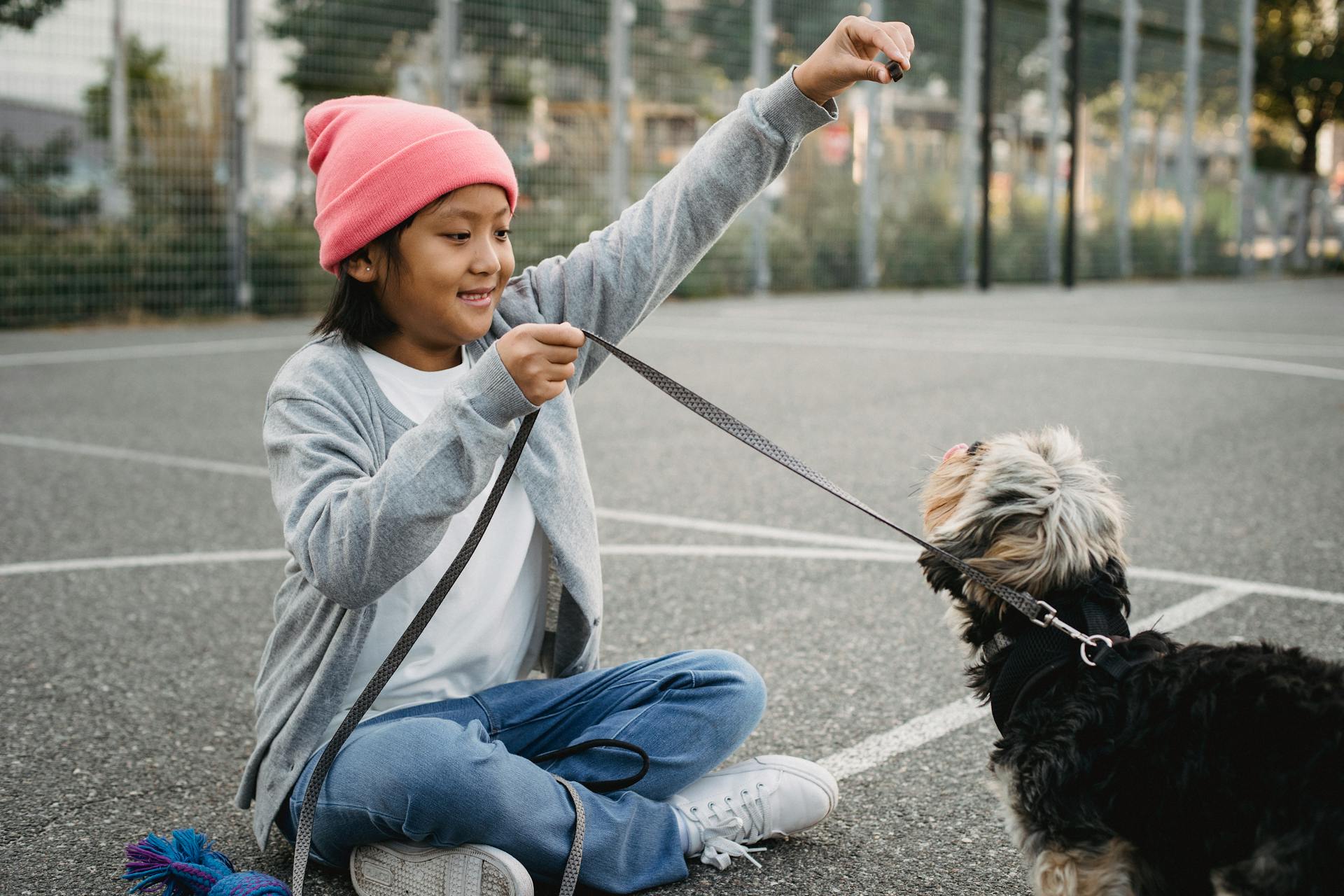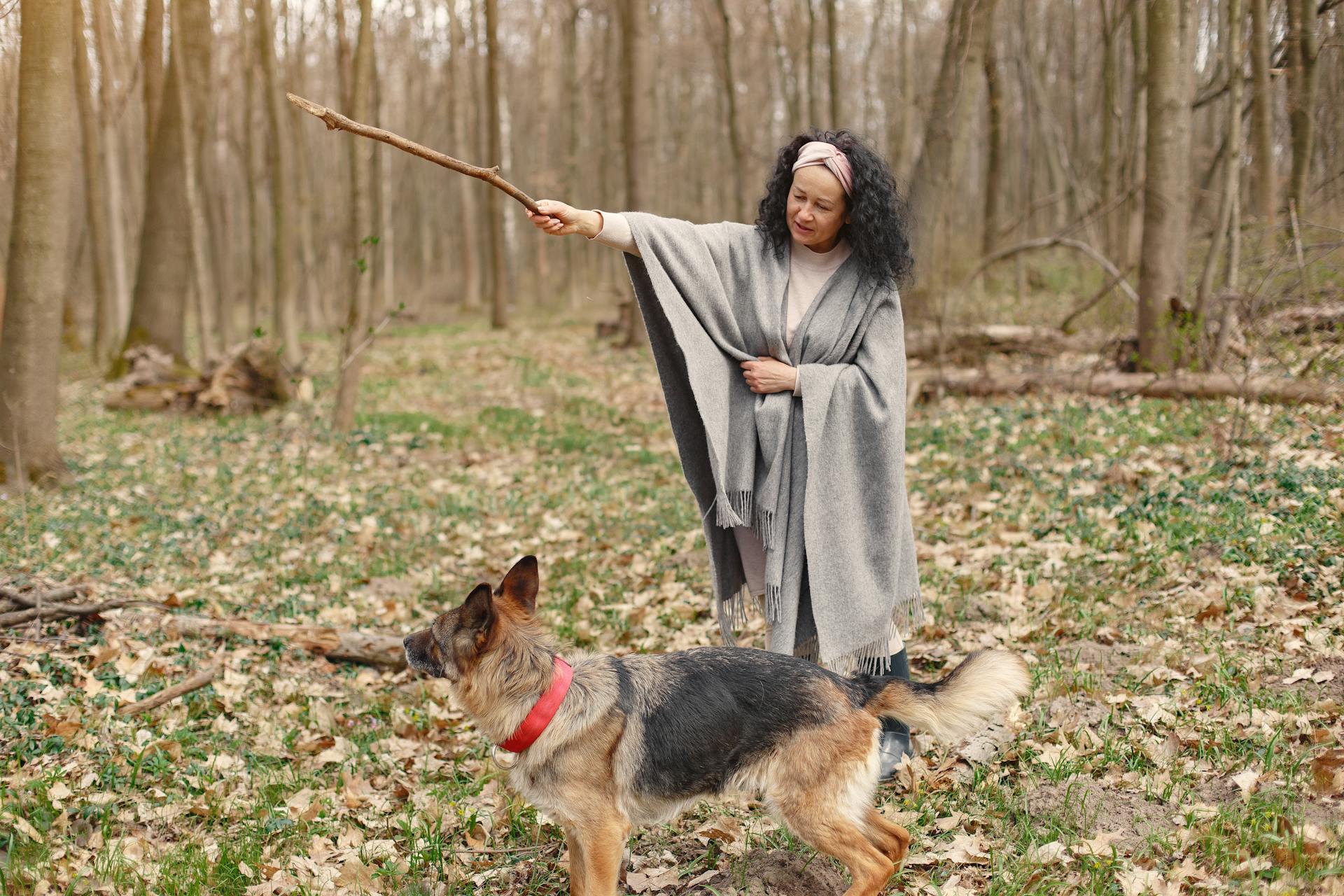
Dog whistles have been touted as a miracle solution to stop barking, but do they really work? Research suggests that they can be effective, but only for certain types of dogs.
Some dogs, especially those with a strong prey drive, are highly sensitive to high-pitched sounds and may be deterred by the sound of a dog whistle.
Training Methods
Using a dog whistle can be an effective way to train your dog, and one of the key advantages is that it can be used by anyone, regardless of their voice or emotional state.
A whistle-generated sound can travel a significant distance, making it easier to call your dog back while outside, and it's also "emotionless", which means your dog won't get confused or stressed by it.
To use a whistle effectively, you need to adjust the frequency and start using it until your dog responds. It's essential to use separate sounds for different commands, so your dog can associate each sound with a specific action.
Additional reading: Dog Bark Stop Sound
Using a whistle can be especially helpful for training basic commands like "sit", "recall", and "stop." These commands are commonly trained using a whistle, and with consistent use, your dog can learn to follow them without confusion.
The key to successful whistle training is to use a consistent sound for each command and to reward your dog with treats or toys when they respond correctly.
Curious to learn more? Check out: Why Use a Clicker for Dog Training
Ultrasonic Devices
Ultrasonic devices are a type of noise-making device that produce high-pitched sounds in response to barking.
These devices are designed to annoy dogs, causing them to stop barking when they hear the tone. They come in both indoor and outdoor versions, and can detect barking from any dog within range.
The outdoor machines are great for shushing dogs in your neighbors' yards, preventing barking competitions between your dog and theirs. However, if you have multiple dogs and only one is a nuisance barker, all dogs will receive the device's correction.
Curious to learn more? Check out: Do Dog Barking Devices Work
Consult with a professional trainer for advice on using these devices with your individual dog. Placement is key, as the machine should be facing your dog and your dog must be within the detection area of the machine's microphone.
Keep the area between the dog and the device clear so nothing blocks the ultrasonic noise, and be sure to turn the machine off when you aren't dealing with nuisance barking.
Training Tools and Recommendations
A whistle can be a great training tool because it's a consistent sound that your dog can recognize, unlike a human voice which can vary in tone and pitch. This means you can use a whistle to give your dog commands without confusing them.
The sound of a whistle can travel a long distance, making it perfect for calling your dog back while outside. You can use it to get your dog's attention without startling others nearby.
To implement a whistle as a tool in your training, it's essential to use separate sounds for different commands, so your dog can associate each sound with a specific action.
Worth a look: Dog High Pitched Sound Stop Bark
Distraction Toys
Distraction toys are a great way to keep your dog's mind off barking triggers, providing mental stimulation and conquering boredom.
You can stuff these toys with kibble or other food that require your dog to work to get at the treats inside.
If you learn your dog's barking triggers, you can provide a distraction toy before the trigger arrives, keeping your dog so involved in getting the food that the trigger goes unnoticed.
These toys are also great for keeping your dog busy when you're out of the house, reducing worries about your absence or barking at passersby.
You can use distraction toys as rewards in a training program, turning a time-out from a punishment into a chance to settle down.
A unique perspective: How to Stop Dog from Eating Other Dogs Food
Trainers Recommend a Training Tool
Trainers recommend a whistle as a training tool because it can be used by anyone, not just professional trainers. This consistency is key to a dog's learning process.
Consider reading: E Collar Dog Trainers

The sound generated by a whistle travels further than a human voice, making it a great tool for calling your dog back from a distance. This can be especially helpful when you're outside and want to get your dog's attention without disturbing others.
Using a whistle also helps to keep emotions out of the training process. A whistle-generated sound is considered "emotionless", which means your dog won't get confused or stressed by your emotions. This is particularly important during training, where a calm and patient approach is essential.
To use a whistle effectively, blow it to get your dog's attention, then give a command, such as "stop" or "quiet." Reward your dog when they comply with the command.
For your interest: When Do Dogs Stop Being a Puppy
Training Principles and Tips
A whistle can be a useful tool for training your dog, as it can be recognized by your dog and associated with a certain command, regardless of who uses it.
It's essential to use separate sounds for different commands, such as one sound for "come" and another for "sit", to avoid confusing your dog.
You can start by adjusting the frequency of the whistle and then blowing it until your dog responds.
A key principle of whistle training is to reward your dog with treats or toys for good behavior, which is crucial for the training success.
The regular rewarding of your dog is essential, especially in the beginning, to help them understand the whistle command.
Curious to learn more? Check out: Training Dog Whistle
Training Tips
A whistle is a versatile training tool that can be used by anyone, not just professional trainers. It's essential to use a whistle that generates a consistent sound, so your dog can associate it with a specific command.
Use a whistle to get your dog's attention, especially when you're outside and need to call them back. The sound of a whistle can travel farther than a human voice, making it easier to communicate with your dog.
For another approach, see: How to Use a Shock Collar to Stop Barking
It's crucial to keep the sound of the whistle "emotionless" to avoid confusing or stressing your dog. This means using the whistle calmly and not letting your emotions get the best of you.
To train your dog to stop barking, blow the whistle to get their attention, then give a command like "stop" or "quiet." Reward your dog with treats and praise when they comply.
Use separate sounds for different commands to avoid confusing your dog. For example, use one sound for the "come" command and a different one for the "sit" command.
Regularly rewarding your dog with treats or toys is crucial for successful whistle training. Start with small treats and gradually phase them out as your dog becomes more responsive to the whistle.
In the beginning, it's a good idea to use both verbal commands and whistle commands to help your dog understand what you want. Once they're familiar with the whistle command, you can phase out the verbal commands.
Positive reinforcement training is an excellent way to encourage good behavior in your dog. Reward your dog with treats, praise, and affection when they exhibit desired behaviors, such as sitting quietly or responding to the whistle command.
If this caught your attention, see: Shock Collar Doesn T Phase Dog

Clicker training can be a useful tool in positive reinforcement training. Use a clicker to mark the exact moment your dog performs a desired action, then reward them with treats and praise.
Remember to be patient and consistent when using a whistle for training. It may take time for your dog to learn the association between the whistle sound and the command.
For your interest: Clicker Training for Puppies
Training Principles and Tips
Understand that dogs bark for various reasons, including anxiety, boredom, and protectiveness. It's essential to identify the cause of the barking to address the behavior effectively.
Dogs left alone for long periods without stimulation are likely to bark excessively due to boredom. Providing puzzle toys and interactive games can help keep them occupied and reduce barking.
Anxiety or fear can also trigger excessive barking. Separation anxiety, fear of strangers or other dogs, and loud noises are common triggers. Identifying the root cause of the anxiety is crucial to address the behavior.
Readers also liked: Separation Anxiety in Dogs Barking
Medical conditions can cause excessive barking as a way to communicate discomfort. If your dog's barking behavior has changed or increased suddenly, have them examined by a veterinarian to rule out any underlying medical conditions.
Some breeds of dogs are more prone to excessive barking than others. Beagles, Terriers, and Schnauzers are known for their tendency to bark excessively. Understanding breed-specific characteristics can help you address excessive barking behavior effectively.
Here are some tips to help you address excessive barking:
- Provide plenty of toys and activities to keep your dog occupied.
- Identify and address the root cause of anxiety or fear.
- Consult with a veterinarian to rule out any underlying medical conditions.
- Consider using a dog whistle to distract your dog from the stimulus causing the barking.
Document the Issue
Documenting the issue is a crucial step in addressing problems like dog barking. It helps you determine if it's a recurring issue or a one-off incident.
Start by tracking and documenting every time you notice or hear the dog barking. This can be as simple as jotting down the time of day, what's happening in the environment, and how long the barking lasted.
Having a dog barking log will be beneficial when you talk to the neighbors. It allows you to reference patterns you've noticed and provide concrete evidence of the issue.
A fresh viewpoint: How to Have a Dog When You Work Full Time
Safety and Effectiveness
Whistle training can be safe for your dog if done correctly, but it's essential to consider your dog's individual response to noise.
You should never blow the whistle too loudly and for too long, as this can be overwhelming for your dog.
Direct contact with your dog's ears should be avoided, as the sound may be harmful.
Whistle training may not be suitable for fearful canines, as it could cause even more stress and anxiety.
Technology and Apps
Dog whistles are a great tool for getting your pet's attention, and they can be especially helpful during training. Every dog is different, though, and will respond to differently pitched frequencies.
Most dog whistle apps come with a range of frequencies to choose from, so you can find the one that works best for your pup. You can use the app during training, ideally paired with treats, instead of using a clicker.
There are quite a few dog whistle apps available on both Android and IOS, but it's best to go with an app that has a high rating and good reviews. A few options to consider include Dogo, Dog Whistle & Training, iTrainer Dog Whistle, Dog Whistle with Training Lessons, and Dog Whistler, the Original.
You may need to try out more than one app to find one with a frequency that works for your dog, but that's easily accomplished.
Take a look at this: Crate Training during the Day
Benefits and Recall
Using a dog whistle can be a great way to teach your dog the "recall" command, which means they'll come to you when you blow the whistle. This can be especially helpful in situations where your dog might get distracted and run off.
You can start training your dog in a distraction-free room at home, where they can focus on learning the command. It's essential to use a lot of treats to reward your dog for coming to you when they hear the whistle.
A fresh viewpoint: When Do Dogs Stop Eating Everything
Benefits of Mental Stimulation
Providing mental stimulation for your dog can have numerous benefits for their overall well-being. Dogs that receive regular mental stimulation are better able to learn new things, solve problems, and retain information.
Mental stimulation can help prevent destructive behaviors in dogs, such as chewing, digging, or excessive barking. This is because dogs that are bored or understimulated are more likely to engage in these behaviors.

Dogs that receive mental stimulation are also more likely to be calm and focused, making them easier to train. Training your dog with a whistle, for example, can be an effective way to teach them new commands or behaviors.
Providing mental stimulation can also reduce barking behavior in dogs. This is because dogs that are bored or lacking in mental stimulation may bark excessively.
Engaging in activities such as puzzle games, scent work, or obedience training can be a fun way to provide mental stimulation for your dog. These activities can also strengthen the bond between you and your dog.
How to Recall
Recalling your dog is a skill that takes time and patience to develop. Start the training process in a distraction-free room in your home.
To begin, you'll need a lot of treats to motivate your dog. You can wait a few minutes to let your dog have some alone time before starting the training.

Use a whistle and give a command, and your dog may get interested in the sound and come to you. Praise and reward your dog as soon as they respond.
Keep in mind that you don't have to force your dog to come to you. Repeat the training several times, keeping the sessions short.
As your dog becomes more confident, you can move the training outdoors. Start with places with low distractions and use the whistle when your dog walks a few steps away. Reward them as soon as they return to you.
If your dog is unsure about coming back, try moving in the opposite direction to motivate them. Gradually increase the distance when using the whistle and recall your dog.
The training methods remain the same, rewarding your dog every time they recognize the sound and fulfill the command.
You might enjoy: Reward Based Dog Training
Frequently Asked Questions
What is the best command to stop a dog from barking?
The "quiet" command is a simple yet effective way to stop a dog from barking. Use a calm, firm voice to teach your dog this command and positively reinforce correct behavior with treats and affection.
Sources
- https://www.akc.org/expert-advice/training/bark-control-tools-to-help-stop-nuisance-barking/
- https://www.servicedogtrainingschool.org/blog/how-to-use-a-dog-whistle
- https://www.dogster.com/dog-training/do-dog-whistle-apps-work
- https://www.apartmentguide.com/blog/neighbors-dog-wont-stop-barking/
- https://dogbarkingstopper.com/blogs/news/do-dog-whistles-work
Featured Images: pexels.com


